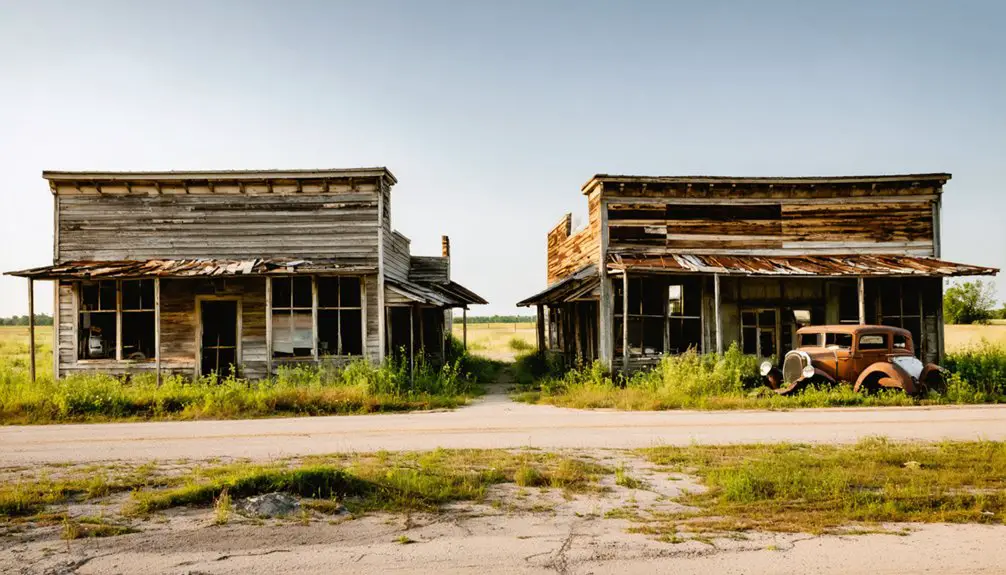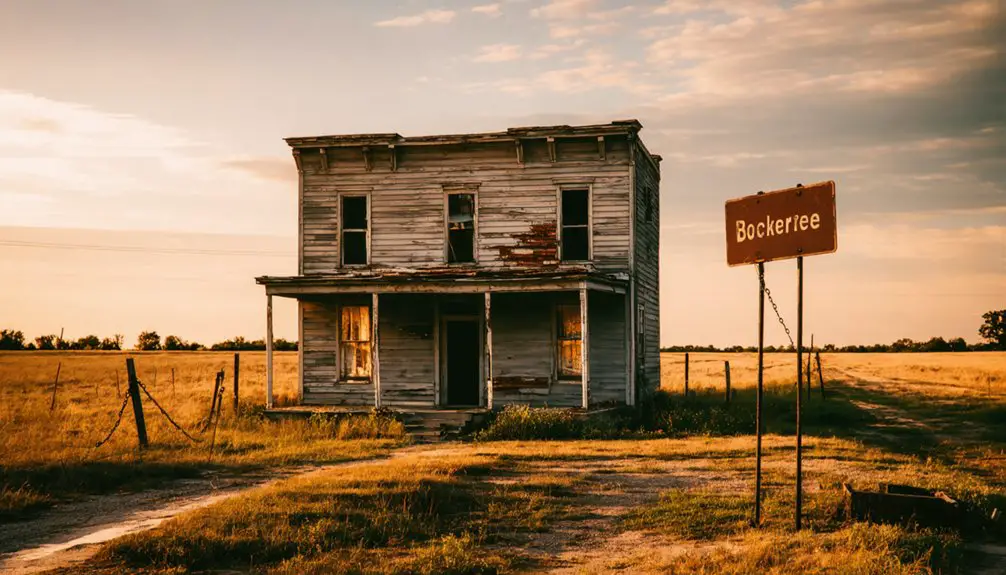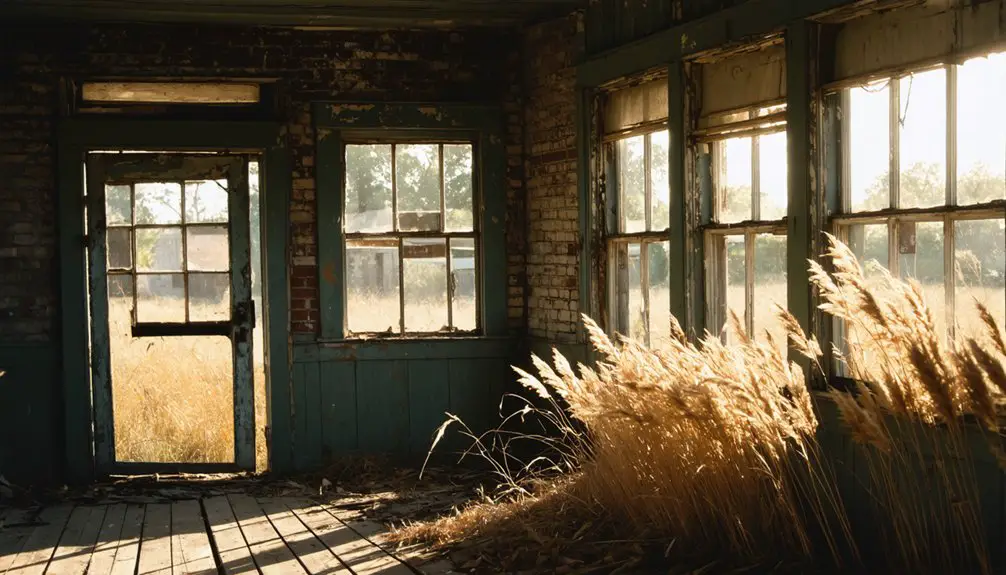You’ll find Bookertee among Oklahoma’s historic all-Black settlements, established in the early 1900s by freed African Americans and Native American freedmen. Named after educator Booker T. Washington, this self-governed community thrived through cotton farming, churches, and Black-owned businesses until the Great Depression. While economic shifts and the Great Migration led to its decline, Bookertee’s legacy lives on through preservation efforts that tell a powerful story of Black independence and achievement.
Key Takeaways
- Bookertee was one of over 50 all-black settlements in Oklahoma established by freed African Americans and Native American freedmen.
- The town thrived in the early 1900s with self-built churches, schools, and businesses centered around cotton farming and railroad access.
- Bookertee’s community featured the Booker T. Washington High School and Black-owned businesses, creating a haven from racial discrimination.
- The Great Depression, declining agriculture, and altered railroad routes led to the town’s abandonment as residents sought opportunities elsewhere.
- The Coltrane Group now leads preservation efforts through heritage tours and educational programs to maintain Bookertee’s historical significance.
The Legacy of an All-Black Settlement
After the Civil War, freed African Americans and Native American freedmen established vibrant all-black settlements in Indian Territory, now known as Oklahoma. Fleeing racial violence in the South, these pioneers created safe havens where they could build autonomous communities and thrive.
Bookertee emerged as one of more than 50 such settlements, demonstrating remarkable community resilience through its self-governed institutions and agricultural economy. The town’s residents focused heavily on cotton farming operations as their economic foundation. Like many similar towns, it experienced significant decline during the Great Depression.
Against incredible odds, Bookertee stood as a testament to black autonomy, building prosperity through self-governance and farming innovation.
Though most of these towns have vanished, their legacy endures as a powerful representation of black independence and achievement.
Bookertee’s educational heritage stood out particularly, as the town welcomed orphans from the Tulsa Race Riot and prioritized learning through dedicated teachers and schools.
The settlement exemplified the broader movement of African American self-determination, with residents creating their own markets, businesses, and social networks.
Geographic Location and Physical Remnants
Nestled in Muskogee County at an elevation of 764 feet, Bookertee’s original townsite sits at coordinates 35.3673°N, 96.0833°W in northeastern Oklahoma.
Today, you’ll find the landscape has returned to its natural state, with the only remaining feature being the historic railway track that once served as the town’s lifeline. Like many ghost towns documented in case studies, Bookertee illustrates the dramatic impact of economic changes on rural communities.
A spatial analysis of the area reveals gently rolling topographic features typical of eastern Oklahoma, with mixed grasslands and scattered trees dotting the terrain. Visitors to the site must complete a verification process to access historical records and maps of the original township.
While the town’s physical structures have vanished completely, the railway corridor still cuts through the former settlement.
You won’t find any marked access points or preserved foundations at the site – the land has largely reverted to open fields, leaving only historical records to tell Bookertee’s story.
Historical Origins and Development
Bookertee emerged in the early 1900s as one of Oklahoma’s notable all-black communities, joining over 50 similar settlements that dotted the region during that era. The town’s founding significance stemmed from African Americans’ pursuit of autonomy and opportunity in the post-Reconstruction era, likely named after the influential educator Booker T. Washington.
Similar to Navajoe’s first Baptist Church establishment, Bookertee’s residents showed their commitment to faith by building their own houses of worship.
You’ll find that community resilience defined Bookertee’s development, as residents established their own churches, schools, and businesses. Like Gray Horse, the town experienced a tragic decline when oil wealth reshaped the region’s demographics.
The railroad’s presence helped connect the town to wider markets, while agriculture formed the backbone of the local economy.
Despite facing structural challenges and racial discrimination, Bookertee’s residents built a self-sufficient community that represented black empowerment and self-determination, creating their own haven from the Jim Crow South’s oppression.
Life in Early 20th Century Bookertee
In early 20th century Bookertee, you’d find daily life centered around vibrant churches that served not just as places of worship but as essential social and educational gathering spaces.
Your children would have attended the local segregated schools, including Booker T. Washington High School established in 1913, where African American educators fostered both academic achievement and community pride. These institutions provided economic self-help through cooperative farming ventures and financial assistance between neighbors.
Whether at church functions or school events, you’d experience a close-knit community where these institutions worked together to strengthen social bonds and create opportunities for cultural expression despite the challenges of segregation. Like many African American settlements of the era, the town was established as a haven for mutual protection from the discrimination found in mixed communities.
Daily Community Activities
Life in early 20th century Bookertee bustled with economic and social activity centered around its Black-owned businesses, farms, and community gathering spaces.
You’d find farmers tending cotton fields during planting and harvest seasons, while merchants operated stores supplying essential goods and services. Local banks provided vital capital for business ventures and farming operations.
Throughout the year, you’d experience vibrant community gatherings at schools, churches, and social clubs. The three cotton gins supported the town’s thriving agricultural economy. Like Booker T. Washington High School in 1913, these institutions served as pillars of Black educational and economic advancement. Seasonal celebrations often coincided with agricultural cycles, bringing together residents for dances and fairs.
The town’s infrastructure, including an electrical plant and ice-making facilities, supported daily life, while newspapers kept you connected to local happenings.
Despite occasional social divisions, the community’s mutual aid networks fostered resilience and economic interdependence, creating a self-sustaining haven of Black enterprise and cultural pride.
Church and School Life
Churches and schools formed the bedrock of Bookertee’s social fabric, extending their influence far beyond Sunday services and daily lessons. You’d find multiple denominations serving the community, with the AME Church playing a particularly prominent role in both spiritual and educational leadership.
Church activities included everything from social gatherings to community meetings and educational programs.
If you were raising children in Bookertee, you’d have access to both public and private schooling options, including the nearby Halochee Industrial Institute. The curriculum balanced academic subjects with practical skills training, preparing students for professional careers or entrepreneurship.
Through the railroad’s connectivity, you could reach higher education institutions like Creek-Seminole College and Flipper-Davis Junior College, while local schools hosted vibrant extracurricular activities that strengthened community bonds.
Cultural Impact and Social Significance

While many ghost towns fade into obscurity, Bookertee’s cultural legacy endures as a powerful symbol of African-American resilience and self-determination in post-Reconstruction Oklahoma.
Named after Booker T. Washington, the town embodied cultural resilience through its role in fostering Black autonomy and community identity during an era of systemic discrimination.
You’ll find Bookertee’s significance reflected in three key aspects:
- It served as a safe haven where African Americans could freely develop their own economic, social, and political institutions.
- The town strengthened community bonds through shared cultural traditions, religious worship, and educational pursuits.
- As part of Oklahoma’s network of all-Black towns, it contributed to a broader movement of African-American self-governance and cultural preservation.
Factors Leading to Abandonment
Although Bookertee initially thrived as a self-sustaining Black community in Oklahoma, several interconnected factors led to its eventual abandonment in the early 20th century.
Economic shifts severely impacted the town as natural resources dwindled and agricultural opportunities declined. When transportation changes altered railroad routes, Bookertee’s isolation deepened, cutting off crucial commercial connections that had once sustained the community.
You’ll find that these challenges coincided with the Great Migration, as many residents sought better opportunities in urban areas. The lack of sustainable economic diversification, combined with aging infrastructure and limited investment in Black communities, made it increasingly difficult to maintain fundamental services.
Without access to resources and faced with demographic shifts, Bookertee’s population gradually dispersed to more promising locations.
Preserving Bookertee’s Historical Memory

Despite Bookertee’s physical disappearance, dedicated preservation efforts affirm its legacy endures as a crucial piece of Oklahoma’s Black heritage.
The Coltrane Group leads historical preservation initiatives through volunteer-driven programs and community engagement activities that keep Bookertee’s story alive for future generations.
Key preservation strategies include:
- Organizing heritage tours that showcase Bookertee’s significance alongside other historic all-black towns
- Documenting oral histories from descendants and incorporating these narratives into educational curricula
- Protecting remaining physical landmarks, especially cemeteries where ancestors rest
You’ll find dedicated volunteers working tirelessly through fundraising, grant writing, and research to guarantee this important piece of African American history isn’t forgotten.
Their work strengthens cultural recognition and inspires broader participation in preserving Oklahoma’s Black pioneer legacy.
Frequently Asked Questions
What Natural Disasters, if Any, Affected Bookertee During Its Existence?
Like footprints in shifting sand, records don’t reveal any specific tornado impact or flood history affecting your community. You won’t find documented natural disasters during Bookertee’s time as a living town.
Were There Any Notable Crimes or Law Enforcement Incidents in Bookertee?
You won’t find documented crime statistics or specific law enforcement incidents from Bookertee’s history. Like many small all-black towns, it likely maintained order through informal community-based policing rather than official authorities.
What Crops or Agricultural Activities Sustained the Town’s Economy?
Like seeds of liberty taking root, you’d find cotton as the main cash crop, while corn and vegetables fed families. Small-scale farming methods and livestock raising helped sustain your community’s self-sufficiency.
Did Any Famous People Besides Booker T. Washington Visit Bookertee?
You won’t find records of other famous visitors or notable residents beyond Booker T. Washington’s symbolic connection to the town’s name. Historical documentation is too limited to confirm any other prominent figures.
What Was the Average Property Value or Cost of Living in Bookertee?
Ever wonder about life in those early black towns? You’ll find that exact property values aren’t documented, but economic factors like railroad access and farming shaped costs, while property trends followed rural Oklahoma’s broader ups and downs.
References
- https://en.wikipedia.org/wiki/Bookertee
- https://echo.snu.edu/the-ghost-towns-of-oklahoma/
- https://www.youtube.com/watch?v=5d-wHDTIbb0
- https://www.kosu.org/local-news/2014-05-23/ghost-towns-all-black-oklahoma-towns
- http://www.african-nativeamerican.com/6-towns.htm
- https://okmag.com/blog/havens-for-freed-slaves/
- https://ronaldclaiborne.substack.com/p/the-all-black-towns-of-oklahoma-once
- https://nondoc.com/2019/07/25/oklahoma-historic-all-black-towns/
- https://www.justiceforgreenwood.org/black-settlement-in-oklahoma/
- https://www.okhistory.org/publications/enc/entry?entry=AL009



